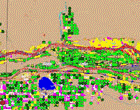CALMIT: Center for Advanced Land Management Information Technologies
Date of this Version
5-1993
Abstract
A vegetation index and a radiative surface temperature were derived from satellite data acquired at approximately 1330 LST for each of 37 cities and for their respective nearby rural regions from 28 June through 8 August 1991. Urban-rural differences for the vegetation index and the surface temperatures were computed and then compared to observed urban-rural differences in minimum air temperatures. The purpose of these comparisons was to evaluate the use of satellite data to assess the influence of the urban environment on observed minimum air temperatures (the urban heat island effect). The temporal consistency of the data, from daily data to weekly, biweekly, and monthly intervals, was also evaluated. The satellite-derived normalized difference (ND) vegetation-index data, sampled over urban and rural regions composed of a variety of land surface environments, were linearly related to the difference in observed urban and rural minimum temperatures. The relationship between the ND index and observed differences in minimum temperature was improved when analyses were restricted by elevation differences between the sample locations and when biweekly or monthly intervals were utilized. The difference in the ND index between urban and rural regions appears to be an indicator of the difference in surface properties (evaporation and heat storage capacity) between the two environments that are responsible for differences in urban and rural minimum temperatures. The urban and rural differences in the ND index explain a great amount of the variation observed in minimum temperature differences than past analyses that utilized urban population data. The use of satellite data may contribute to a globally consistent method for analysis for urban heat island bias.


Comments
Published in Journal of Applied Meteorology Volume 32.